1 min read
Active Supermassive Black Holes Across Cosmic Time
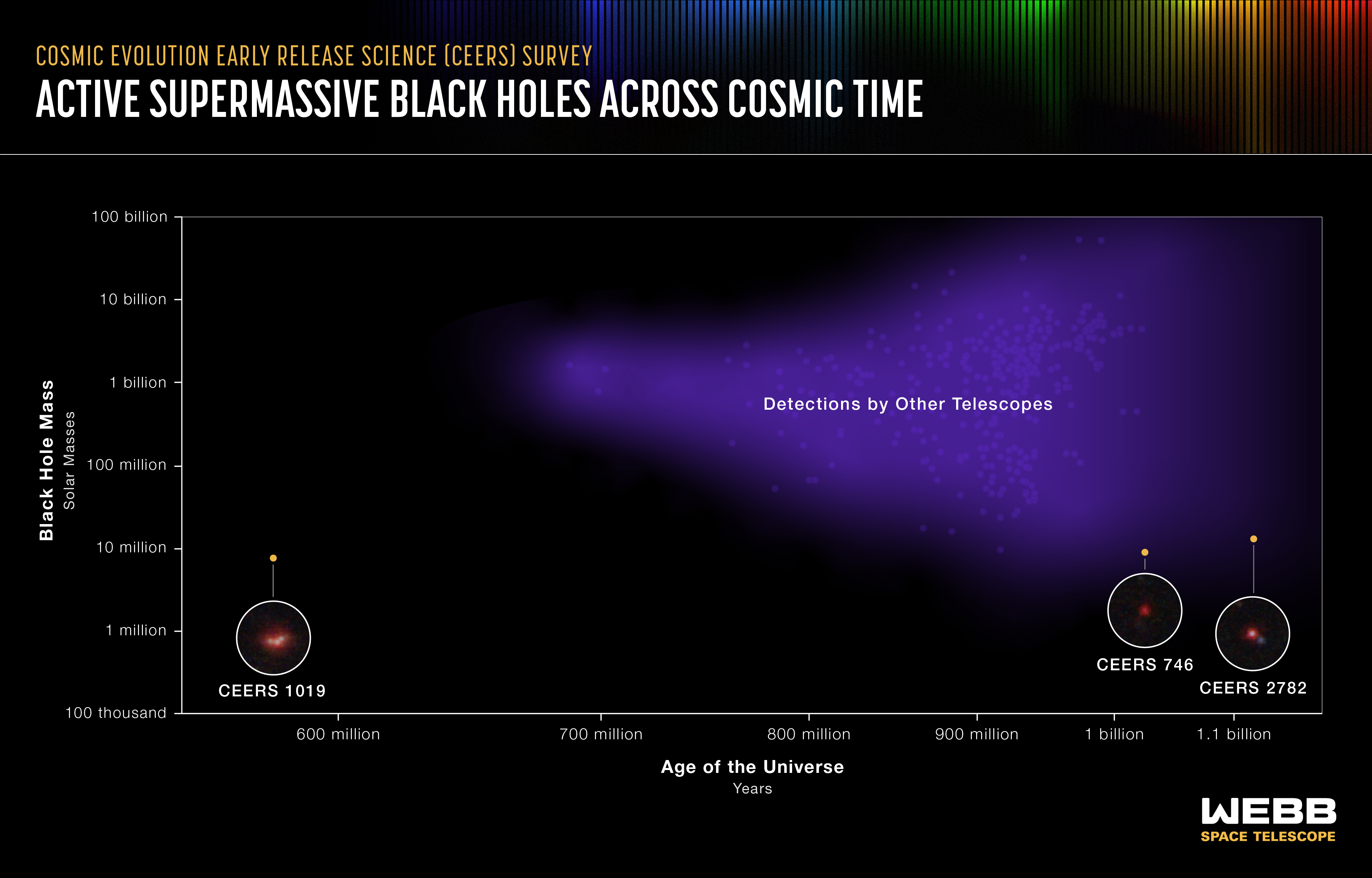
This graphic shows detections of the most distant active supermassive black holes currently known in the universe. They were identified by a range of telescopes, both in space and on the ground. Three were recently identified by in the James Webb Space Telescope’s Cosmic Evolution Early Release Science (CEERS) Survey.
The most distant black hole is CEERS 1019, which existed just over 570 million years after the big bang. CEERS 746 was detected 1 billion years after the big bang. Third place currently goes to CEERS 2782, which existed 1.1 billion years after the big bang.
Knowing they existed is important, but more fully understanding their compositions may ultimately lead us to revise what we know about black holes that existed when the universe was very young. The new CEERS black holes are much smaller than any others researchers have detected. CEERS 1019 weighs only 9 million solar masses. Both CEERS 746 and CEERS 2782 are slightly larger, weighing in at 10 million times the mass of the Sun. All three are more similar to the mass of the black hole at the center of our Milky Way galaxy, which is only 4.6 million times the mass of the Sun, than to other distant behemoths in the early universe we’ve known about previously, which tend to weigh over 1 billion times the mass of the Sun.
The CEERS “light weights” may help completely reshape what we understand about how supermassive black holes formed and grew during the universe’s first billion years. This is critical because the universe was cast in a dense “fog” during this period, known as the Era of Reionization. How did these black holes form in the first place? After they formed, did these black holes help charge or ionize the gas particles, leading to more transparent conditions around their host galaxies?
Researchers certainly need to identify and classify many more extremely distant black holes to begin answering these big questions. This might be as few as a dozen sources, if they all follow the same trend, or upward of 50. In the coming years, Webb’s highly detailed images and data will help astronomers build larger and larger samples of the masses of black hole across cosmic time, and begin to better model how they developed over billions of years. “The more black holes we find, and the earlier we find them, the easier it will be able to put constraints on how they formed and evolved over billions of years,” explained Steven Finkelstein of the University of Texas at Austin, who leads the CEERS Survey.
Extended Description and Image Alt Text
Extended Description
A graphic titled “Cosmic Evolution Early Release Science (CEERS) Survey, Active Supermassive Black Holes Across Cosmic Time.” It is one large line graph.
Graph Axes
The graph shows black hole mass in solar masses on the y-axis, which has points for 100,000, 1 million, 10 million, 100 million, 1 billion, 10 billion, and 100 billion. Age of the universe is shown on the x-axis, which has points for 600 million years, 700 million years, 800 million years, 900 million years, 1 billion years, and 1.1 billion years.
Graph Data
The majority of the data from other telescopes appears just before 700 million years through approximately 1 billion years. There are specific data points, but they appear as tiny purple dots in an area that is shaded purple and roughly forms a boomerang shape. This shaded region reflects that there are more detections nearer to 100 billion solar masses, some ranging as high as 100 billion masses, and fewer near 10 million solar masses.
Three CEERS black holes are plotted. CEERS 1019 appears near the x-axis mark for when the universe was less than 600 million years old and below the 10 million solar mass mark on the y-axis.
CEERS 746 appears immediately after the x-axis mark for when the universe was 1 billion years and at the 10 million solar mass mark on the y-axis.
CEERS 2782 appears a bit farther than CEERS 746 on the x-axis, past the 1 billion years mark, and at the 10 million solar mass mark on the y-axis.
Each CEERS data point is yellow, but a white line connects to a white circle below it. Within each larger circle is a Webb image of the black holes and their host galaxies. All appear as fuzzy red blobs, with CEERS 1019 slightly larger than the other two.
Image Alt Text
A graphic titled “Cosmic Evolution Early Release Science (CEERS) Survey, Active Supermassive Black Holes Across Cosmic Time.” The graphic shows three CEERS detections in the context of those from other telescopes.
- Release DateJuly 6, 2023
- Science ReleaseWebb Detects Most Distant Active Supermassive Black Hole to Date
- CreditIllustration: NASA, ESA, CSA, Leah Hustak (STScI); Science: Steve Finkelstein (UT Austin)
Related Images & Videos

Cosmic Evolution Early Release Science (CEERS) Survey (NIRCam Image)
Stare deeply at this vast landscape. It was stitched together from multiple images captured by the James Webb Space Telescope in near-infrared light – and it is practically pulsing with activity. To the right of center is a clump of bright white spiral galaxies that seem to be...
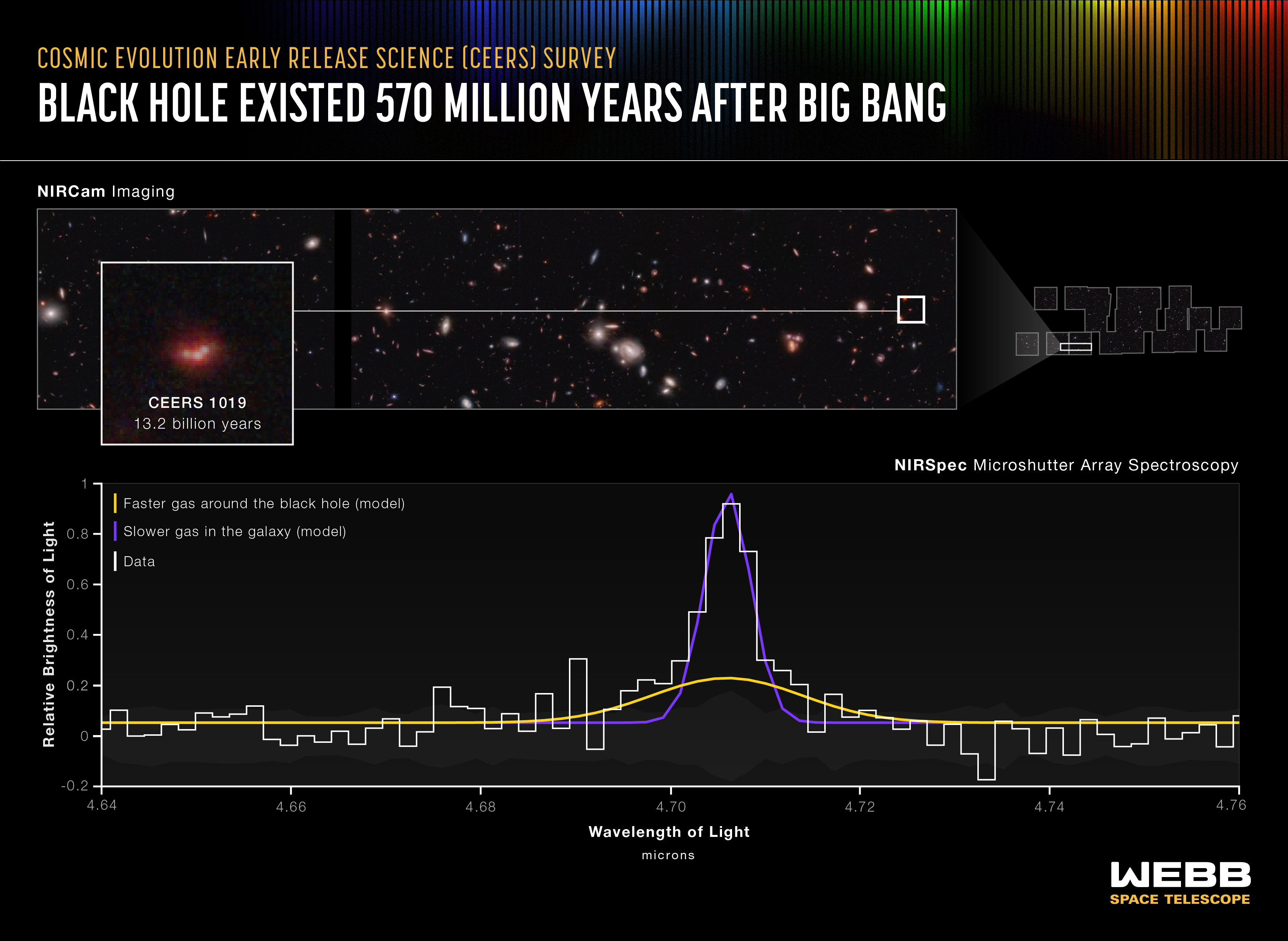
Black Hole Existed 570 Million Years After Big Bang (NIRSpec MSA Emission Spectrum)
Researchers have identified the most distant active supermassive black hole to date in the James Webb Space Telescope’s Cosmic Evolution Early Release Science (CEERS) Survey. The black hole, within galaxy CEERS 1019, existed just over 570 million years after the big bang and...
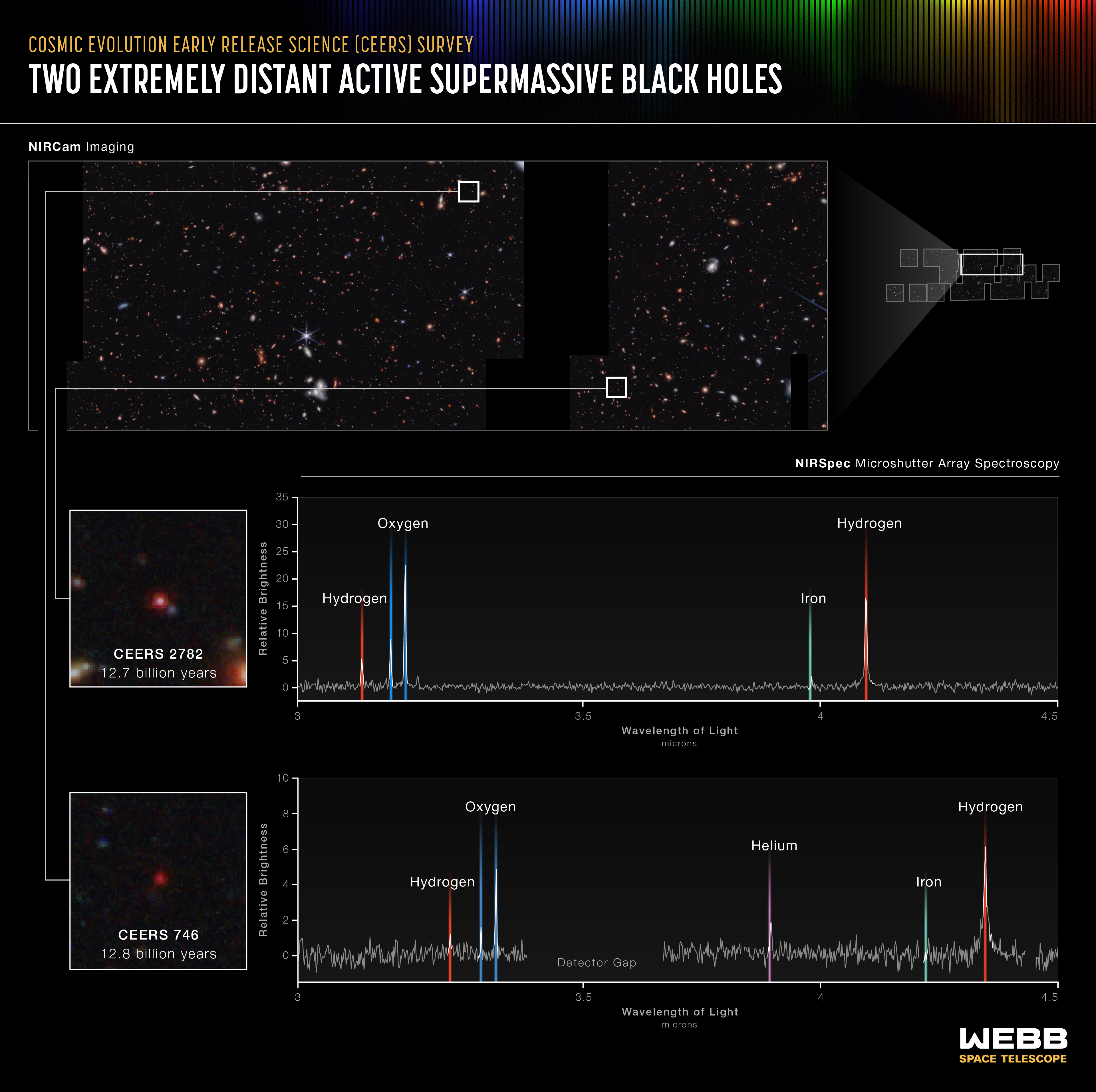
Two Extremely Distant Active Supermassive Black Holes (NIRSpec MSA Emission Spectra)
Researchers using data and images from the James Webb Space Telescope have already captured two of the smallest known supermassive black holes in the early universe. Webb’s spectra show that these black holes weigh only 10 million times the mass of the Sun. Other very distant...
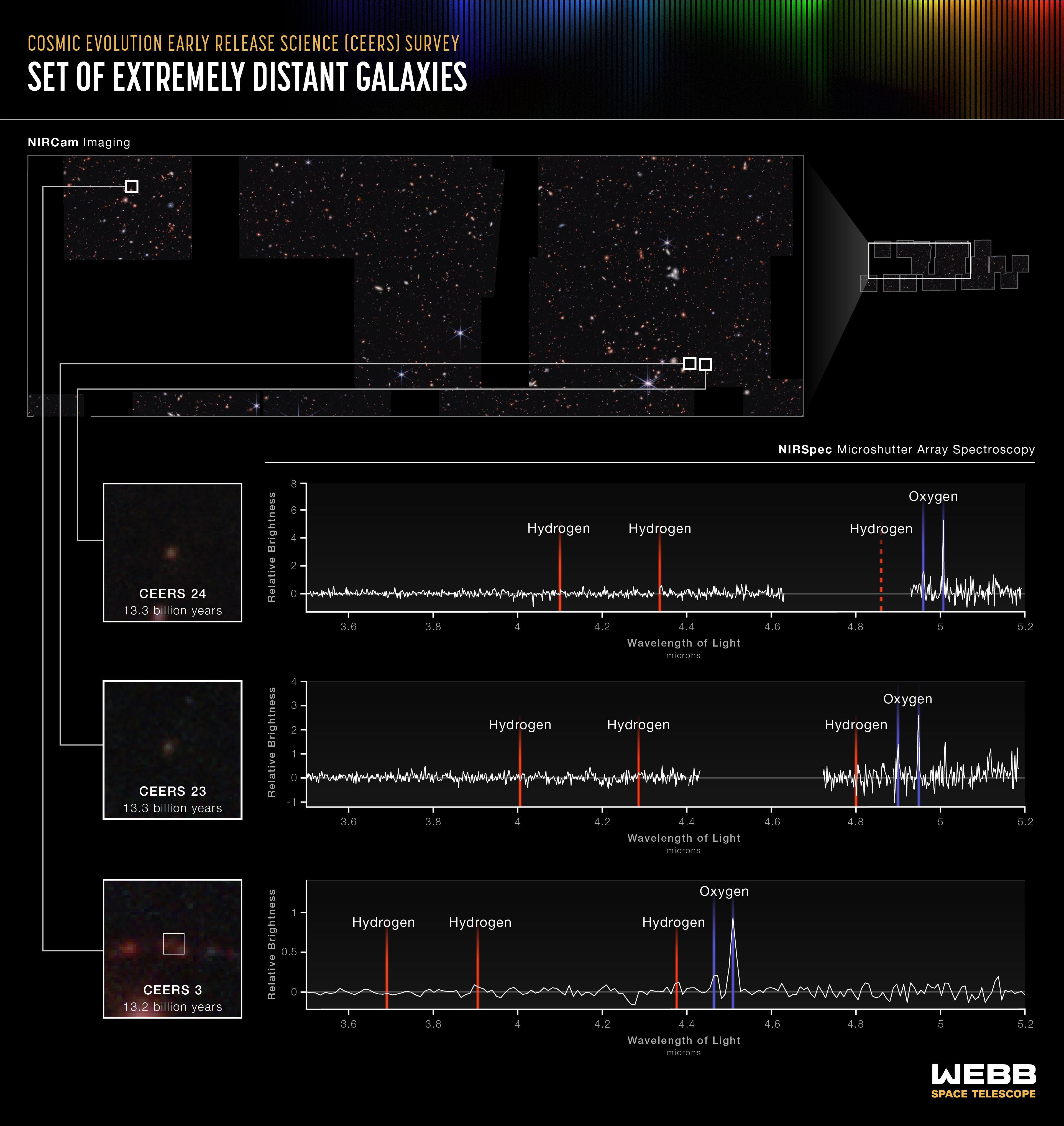
Set of Extremely Distant Galaxies (NIRSpec MSA Emission Spectra)
A team investigating data from Webb’s Cosmic Evolution Early Release Science (CEERS) Survey has already identified seven galaxies that existed when the universe was only 540 to 660 million years old. Some of the evidence is displayed above: Three lines appear in the same order –...
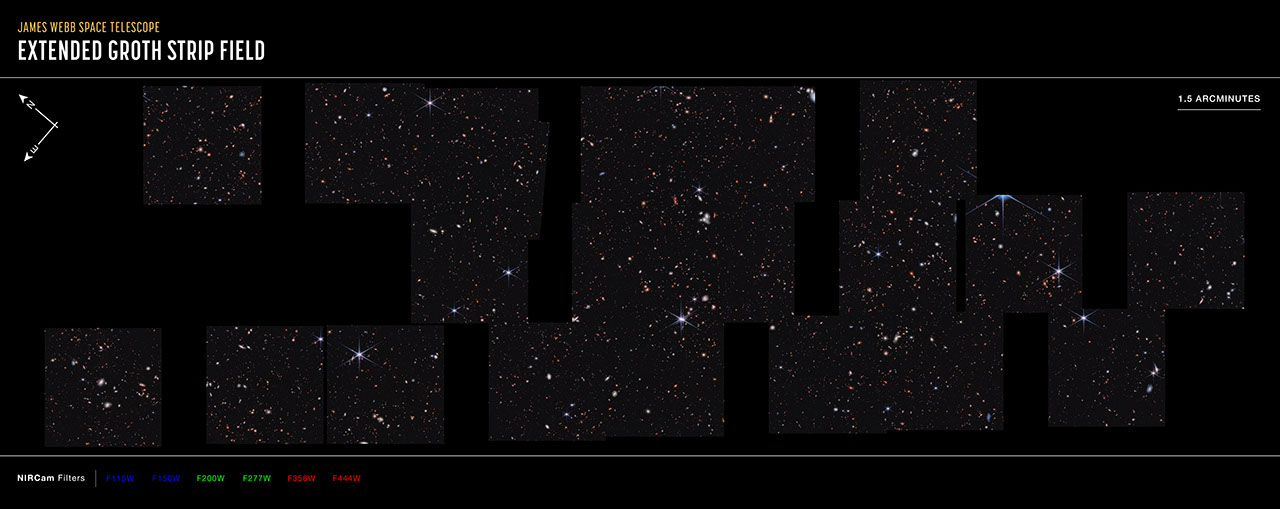
Cosmic Evolution Early Release Science (CEERS) Survey (NIRCam Compass Image)
Ten near-infrared pointings from NIRCam (the Near-Infrared Camera) aboard the James Webb Space Telescope were stitched together to create this mosaic, known as the Cosmic Evolution Early Release Science (CEERS) Survey. These observations are within the same region studied by the...
Share
Details
Laura Betz
NASA’s Goddard Space Flight Center
Greenbelt, Maryland
laura.e.betz@nasa.gov
NASA, ESA, CSA, Leah Hustak (STScI)
Steve Finkelstein (UT Austin)































